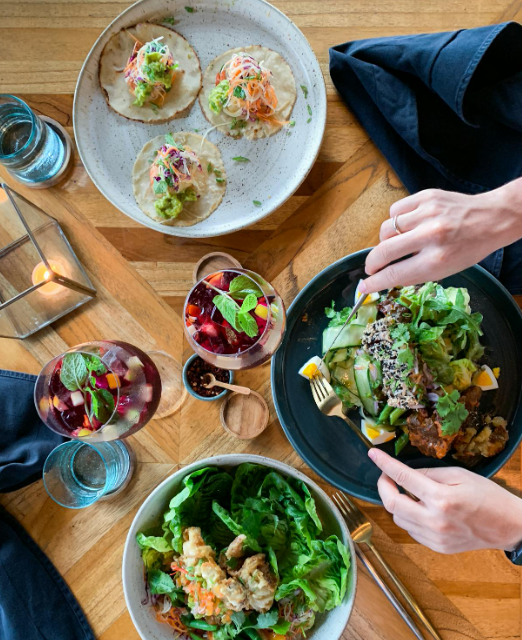We asked health experts to break down how eating smarter, especially with the DASH Diet, can make a real difference in managing high blood pressure
Annette Snyder, MS, RD, CSOWM—Dietitian, Top Nutrition Coaching says:
One out of every three adults world-wide has high blood pressure (hypertension). Lifestyle changes can help lower your blood pressure, especially when you include foods rich in certain nutrients. The ever-popular DASH Diet (Dietary Approaches to Stop Hypertension) is designed with this in mind.
Just relax — with nutrition know how
Potassium is a mineral that relaxes the walls of blood vessels, which in turn lowers the pressure. It’s important for muscle function, including that of the heart beating. Our kidneys keep tight control over the amount of potassium in the body, along with other nutrients. There is strong evidence that higher blood pressure is linked with low potassium intake.
Recommended amount per day for nonpregnant adults: 2600-3400 mg

Lena Bakovic, MS, RDN, CNSC at Live It Up recommends:
Vegetables rich in potassium*:
- Beet greens (1309 mg per 1 cup cooked)
- Swiss chard (961 mg per 1 cup cooked)
- Baked potato with skin (926 mg per 1 medium potato)
- Acorn squash (896 mg per 1 cup cooked)
- Spinach (839 mg per 1 cup cooked)
- Cress (606 mg per 2 cups raw)
- Sweet potato (572 mg per 1 cup cooked)
Fruits rich in potassium*:
- Durian (1059 mg per 1 cup)
- Prune juice (707 mg per 1 cup)
- Guava (688 mg per 1 cup)
- Kiwifruit (562 mg per 1 cup)
- Orange juice, 100% (496 mg per 1 cup)
- Banana (451 mg per 1 medium)
*Data source: US Department of Agriculture, Agricultural Research Service. FoodData Central at https://fdc.nal.usda.gov. For an exhaustive list of potassium-rich foods, visit Dietary Guidelines for Americans at https://www.dietaryguidelines.gov/food-sources-potassium.
Magnesium is thought to interact with the mineral calcium and reduce resistance on the walls of blood vessels. It also increases the amount of nitric oxide in the blood. Calcium controls pressure in the vessels, and diets low in calcium have been linked with high blood pressure.
Recommended amount per day for adults (magnesium): 310-420 mg
Foods rich in magnesium*:
- Black beans (120 mg per 1 cup)
- Almonds (80 mg per 1 ounce)
- Cashews (74 mg per 1 ounce)
- Quinoa (118 mg per 1 cup cooked)
- Spinach (157 mg per 1 cup boiled)
- Dark chocolate, 70% (64 mg per 1 ounce serving)
- Avocado (58 mg per 1 fruit)
- Edamame (50 mg per ½ cup shelled and cooked)
Recommended amount per day for adults (calcium): 1000-1300 mg
Foods rich in calcium*
- Yogurt, dairy (425 mg per 1 cup)
- Sardines canned in oil with bones (325 mg per 3 ounces)
- Dairy milk and fortified soy milk (276-399 mg per 1 cup)
- Tofu, made with calcium sulfate (138 mg per ½ cup)
- Spinach, turnip greens, kale (94-123 mg per 1 cup cooked)
*Data source: US Department of Agriculture, Agricultural Research Service. FoodData Central at https://fdc.nal.usda.gov. For an exhaustive list of calcium and magnesium-rich foods, visit the National Institutes of Health, Office of Dietary Supplements at https://ods.od.nih.gov.
Nitric oxide, which we make in the human body, is one of the biggest factors at play in keeping blood vessels healthy. It relaxes the inner muscles of blood vessels, which causes them to widen. By these actions, nitric oxide increases blood flow and lowers the pressure. It’s like getting a brand new water hose that is soft and flexible vs one that has been sitting out in the elements. Certain foods can increase the amount of nitric oxide in the body naturally. Nitrate in foods is converted to nitric oxide.
Foods containing nitrates*:
- celery
- cress
- lettuce
- beetroot
- spinach
- arugula
*Nitrates should not be confused with nitrites, which are used as preservatives in cold cuts, bacon, and hot dogs.
High sodium levels can lead to fluid retention and increased pressure in the blood vessels, which may contribute to side of foot pain, swelling, and inflammation, especially if you’re on your feet often or have circulation issues.

Kat Benson, CSSD, CPT Certified Registered Dietitian at VNutrition adds: Of course, antioxidants have a role here, too. They help neutralize free radicals, which are damaging compounds in the body. Free radicals can shorten the life of nitric oxide. Antioxidants include but are not limited to: Vitamins C and E, polyphenols, and the ever-powerful glutathione. Vegetables high in nitric oxide are also high in antioxidant content. Studies indicate that consuming nitric oxide
precursors along with antioxidants helps keep nitric oxide levels higher. Pretty cool how nature packaged these components together!
Two amino acids that the body makes (L-arginine and L-citrulline) also add to the nitric oxide count, though supplementation of these should be monitored. Nitric oxide supplementation (not food sources) can worsen certain health conditions and interfere with some medications.
Shake it off — the salt, that is
By now, most people are aware that sodium from salt is linked with higher blood pressure. Sodium attracts water and increases the volume of blood coursing through the vessels, which increases the pressure. Using the garden hose example again, it’s like running it on full blast all the time. That’s not going to help the life of the hose over time. The same thing can be said for our blood vessels.
Sources of sodium include obvious culprits, like salty snacks, condiments like soy sauce, added salt to recipes, highly-processed meats, and many pickled foods. But—there are some sneaky places where you might not expect sodium—like cold breakfast cereal and instant pudding mix. Use the label—it’s right there! Aim for 200 mg or less sodium in a single serving of a food, and less than 600-800 mg per entire meal, for a total of 2000-2300 mg total per day. That’s the equivalent of one teaspoon of table salt.
The Final Word
Give your hard-working blood vessels a break by including more nutrients that help them relax. You could extend their life, and your own.
Citations
World Health Organization: WHO. First WHO report details devastating impact of hypertension and ways to stop it. https://www.who.int/news/item/19-09-2023-first-who-report-details-devastating-impact-of hypertension-and-ways-to-stop-it#. Published September 19, 2023. Accessed March 22, 2024.
DASH Eating Plan. National Heart, Lung, and Blood Institute at the National Institutes of Health. Originally published unk date. Updated December 29, 2021. Accessed March 21, 2024.
https://www.nhlbi.nih.gov/education/dash-eating-plan
de Roos B. Diet, blood pressure, and heart disease-precision nutrition approaches to understand response to diet and predict disease risk. Am J Clin Nutr. 2021;114(5):1581-1582. doi:10.1093/ajcn/nqab313
McLean RM, Wang NX. Potassium. Adv Food Nutr Res. 2021;96:89-121. doi:10.1016/bs.afnr.2021.02.013
Villa-Etchegoyen C, Lombarte M, Matamoros N, Belizán JM, Cormick G. Mechanisms Involved in the Relationship between Low Calcium Intake and High Blood Pressure. Nutrients. 2019;11(5):1112. Published 2019 May 18. doi:10.3390/nu11051112
Lubos E, Handy DE, Loscalzo J. Role of oxidative stress and nitric oxide in atherothrombosis. Front Biosci. 2008;13:5323-5344. Published 2008 May 1. doi:10.2741/3084
Król M, Kepinska M. Human Nitric Oxide Synthase-Its Functions, Polymorphisms, and Inhibitors in the Context of Inflammation, Diabetes and Cardiovascular Diseases. Int J Mol Sci. 2020;22(1):56. Published 2020 Dec 23. doi:10.3390/ijms22010056
d’Uscio LV, Milstien S, Richardson D, Smith L, Katusic ZS. Long-term vitamin C treatment increases vascular tetrahydrobiopterin levels and nitric oxide synthase activity. Circ Res. 2003;92(1):88-95. doi:10.1161/01.res.0000049166.33035.62
Kiani AK, Bonetti G, Medori MC, et al. Dietary supplements for improving nitric-oxide synthesis. J Prev Med Hyg. 2022;63(2 Suppl 3):E239-E245. Published 2022 Oct 17. doi:10.15167/2421-4248/jpmh2022.63.2S3.2766
